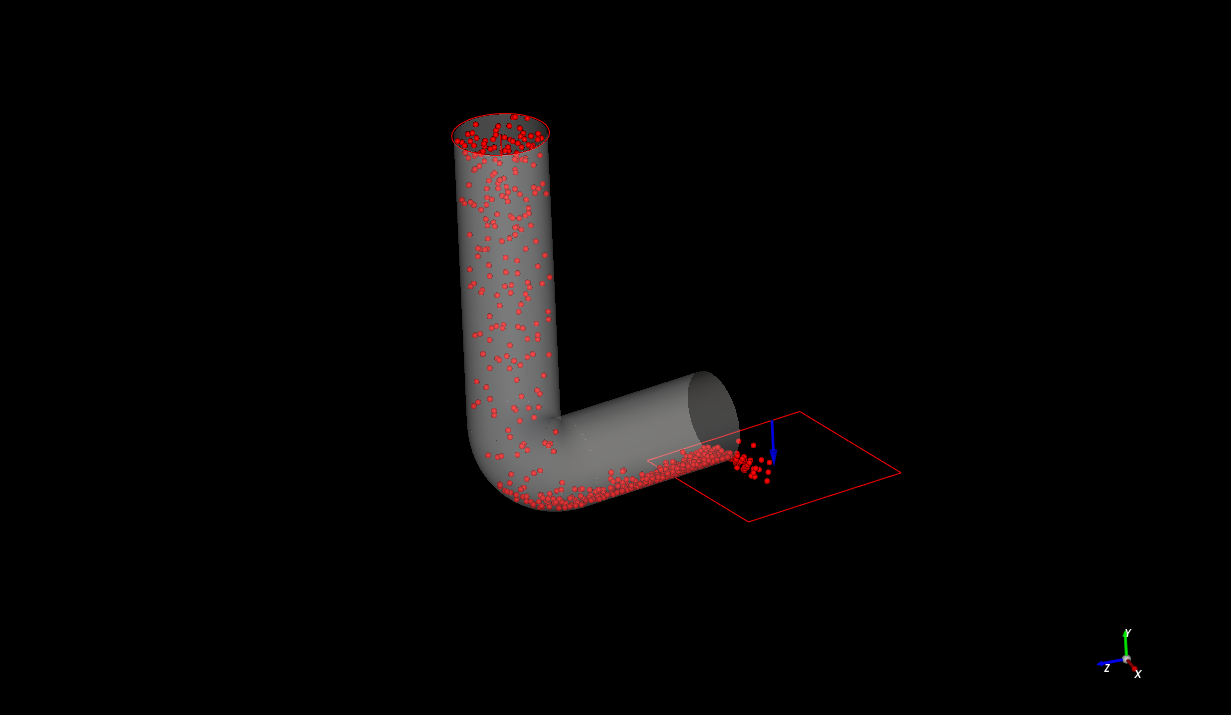Note
Go to the end to download the full example code.
Start Simulation Async#
This example sets up and solves a simulation of particles interacting with a rotating L-shape tube wall using an async call.

Perform imports and create a project#
Perform the required imports and create an empty project.
import os
import tempfile
import time
import ansys.rocky.core as pyrocky
from ansys.rocky.core import examples
awp_roots = sorted(
[k for k in os.environ.keys() if k.startswith("AWP_ROOT")], reverse=True
)
last_rocky_version = int(awp_roots[0].partition("AWP_ROOT")[2])
if last_rocky_version >= 251:
# `non_blocking` simulation only available on Rocky 25R1 and onwards.
# Create a temp directory to save the project.
project_dir = tempfile.mkdtemp(prefix="pyrocky_")
# Launch Rocky and open a project.
rocky = pyrocky.launch_rocky()
project = rocky.api.CreateProject()
project.SaveProject(os.path.join(project_dir, "rocky-testing.rocky"))
###############################################################################
# Configure the study
# ~~~~~~~~~~~~~~~~~~~
study = project.GetStudy()
# Download the STL file that was imported into Rocky to represent a wall.
file_name = "Lshape_tube.stl"
file_path = examples.download_file(project_dir, file_name, "pyrocky/geometries")
wall = study.ImportWall(file_path)[0]
# Create a particle with the default shape (sphere) and size distribution (single
# distribution with a sieve size of 0.1 m).
particle = study.CreateParticle()
# Create a circular surface to used as the inlet.
circular_surface = study.CreateCircularSurface()
circular_surface.SetMaxRadius(0.8, unit="m")
# Create a rectangular surface to use as the outlet.
rectangular_surface = study.CreateRectangularSurface()
rectangular_surface.SetLength(3, unit="m")
rectangular_surface.SetWidth(3, unit="m")
rectangular_surface.SetCenter((5, -7.5, 0), unit="m")
# Set the inlet and outlet.
particle_inlet = study.CreateParticleInlet(circular_surface, particle)
input_property_list = particle_inlet.GetInputPropertiesList()
input_property_list[0].SetMassFlowRate(1000)
outlet = study.CreateOutlet(rectangular_surface)
# Set the motion rotation over the Y axis and apply it on the wall and the
# rectangular surface used as the outlet.
motion_frame_source = study.GetMotionFrameSource()
motion_frame = motion_frame_source.NewFrame()
motion_frame.AddRotationMotion(angular_velocity=((0.0, 0.5, 0.0), "rad/s"))
motion_frame.ApplyTo(rectangular_surface)
motion_frame.ApplyTo(wall)
# The domain settings define the domain limits where the particles are enabled to be
# computed in the simulation.
domain = study.GetDomainSettings()
domain.DisableUseBoundaryLimits()
domain.SetCoordinateLimitsMaxValues((10, 1, 10), unit="m")
###############################################################################
# Set up the solver and run the simulation
# ~~~~~~~~~~~~~~~~~~~~~~~~~~~~~~~~~~~~~~~~
solver = study.GetSolver()
simulation_duration = 5
solver.SetSimulationDuration(simulation_duration, unit="s")
# `non_blocking` only available on Rocky 25R1 and onwards.
study.StartSimulation(non_blocking=True)
###############################################################################
# Postprocess
# ~~~~~~~~~~~
# Obtain the in and out mass flows of the particles while the simulation is
# running.
particles = study.GetParticles()
while study.IsSimulating():
# When running an asynchronous simulation, the call to RefreshResults is required
# to ensure that the results are updated.
study.RefreshResults()
times, mass_flow_in = particles.GetNumpyCurve(
"Particles Mass Flow In", unit="t/h"
)
times, mass_flow_out = particles.GetNumpyCurve(
"Particles Mass Flow Out", unit="t/h"
)
print(f"Simulation Progress: {study.GetProgress():.2f} %")
print(f"\tCurrent mass_flow_in: {mass_flow_in[-1]:.2f} t/h")
print(f"\tCurrent mass_flow_out: {mass_flow_out[-1]:.2f} t/h")
time.sleep(2)
print("Simulation Complete!")
times, mass_flow_in = particles.GetNumpyCurve("Particles Mass Flow In", unit="t/h")
times, mass_flow_out = particles.GetNumpyCurve("Particles Mass Flow Out", unit="t/h")
# Obtain the maximum and minimum velocities of the particles at each time step.
import numpy as np
simulation_times = study.GetTimeSet()
velocity_gf = particles.GetGridFunction("Velocity : Translational : Absolute")
velocity_max = np.array(
[
velocity_gf.GetMax(unit="m/s", time_step=i)
for i in range(len(simulation_times))
]
)
velocity_min = np.array(
[
velocity_gf.GetMin(unit="m/s", time_step=i)
for i in range(len(simulation_times))
]
)
#################################################################################
# Plot curves
# +++++++++++
import matplotlib.pyplot as plt
fig, (ax1, ax2) = plt.subplots(2, 1)
ax1.plot(times, mass_flow_in, "b", label="Mass Flow In")
ax1.plot(times, mass_flow_out, "r", label="Mass Flow Out")
ax1.set_xlabel("Time [s]")
ax1.set_ylabel("Mass Flow [t/h]")
ax1.legend(loc="upper left")
ax2.plot(simulation_times, velocity_max, "b", label="Max Velocity")
ax2.plot(simulation_times, velocity_min, "r", label="Min Velocity")
ax2.set_xlabel("Time [s]")
ax2.set_ylabel("Velocity [m/s]")
ax2.legend(loc="upper left")
plt.draw()
rocky.close()